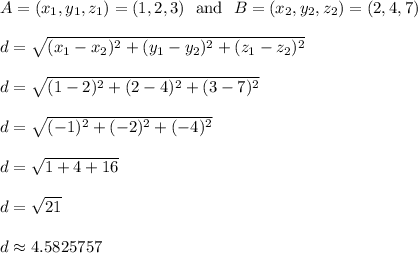Answer: approximately 3.937 square units
Step-by-step explanation
Use the 3D version of the distance formula to determine how far it is from A(1,2,3) to B(2,4,7). This will get us the length of segment AB.

Segment AB is exactly
 units long, which approximates to around 4.5825757.
units long, which approximates to around 4.5825757.
Follow similar steps to find segments BC and AC have lengths of
 units and
units and
 units respectively.
units respectively.
--------------
We have a triangle with these side lengths

Compute the semi-perimeter. Add up the sides and divide in half.

We'll use the values of a, b, c, and s to compute the area of the triangle using Heron's Formula.

The area of the triangle is approximately 3.937 square units.
Round this approximate value however your teacher instructs.